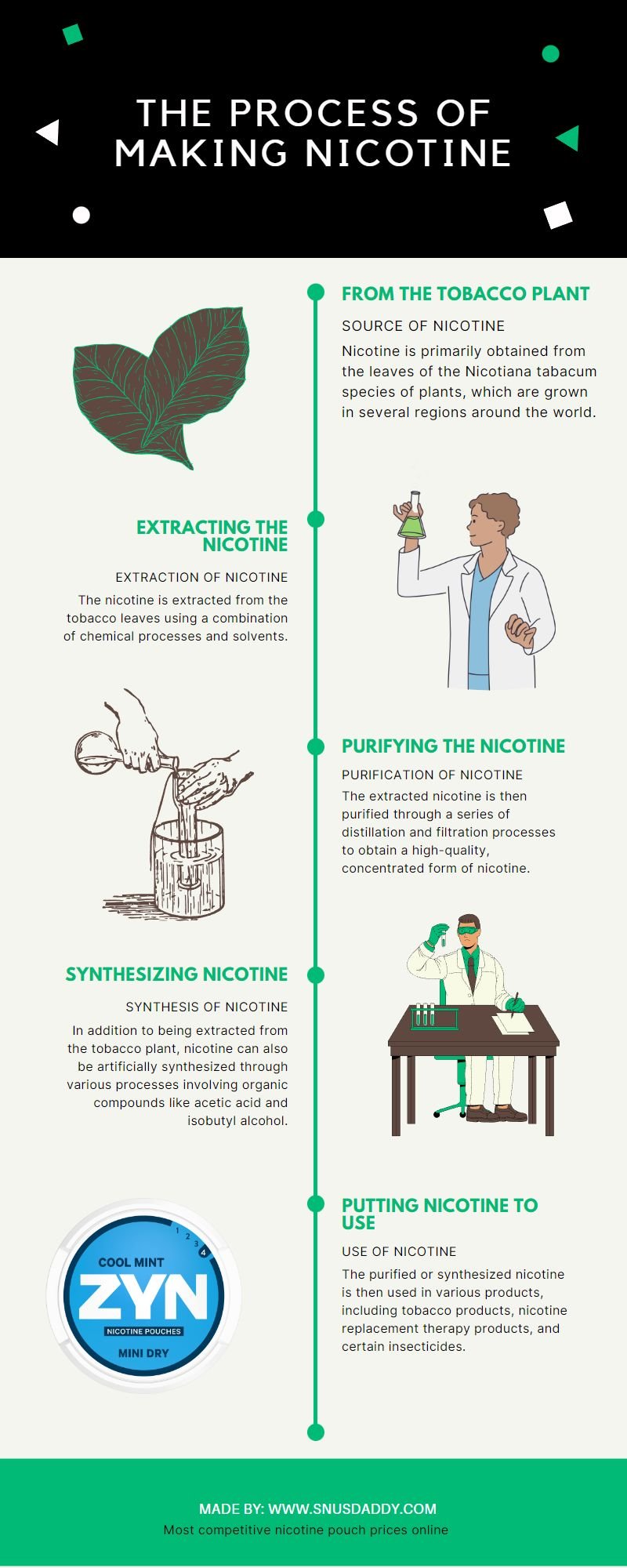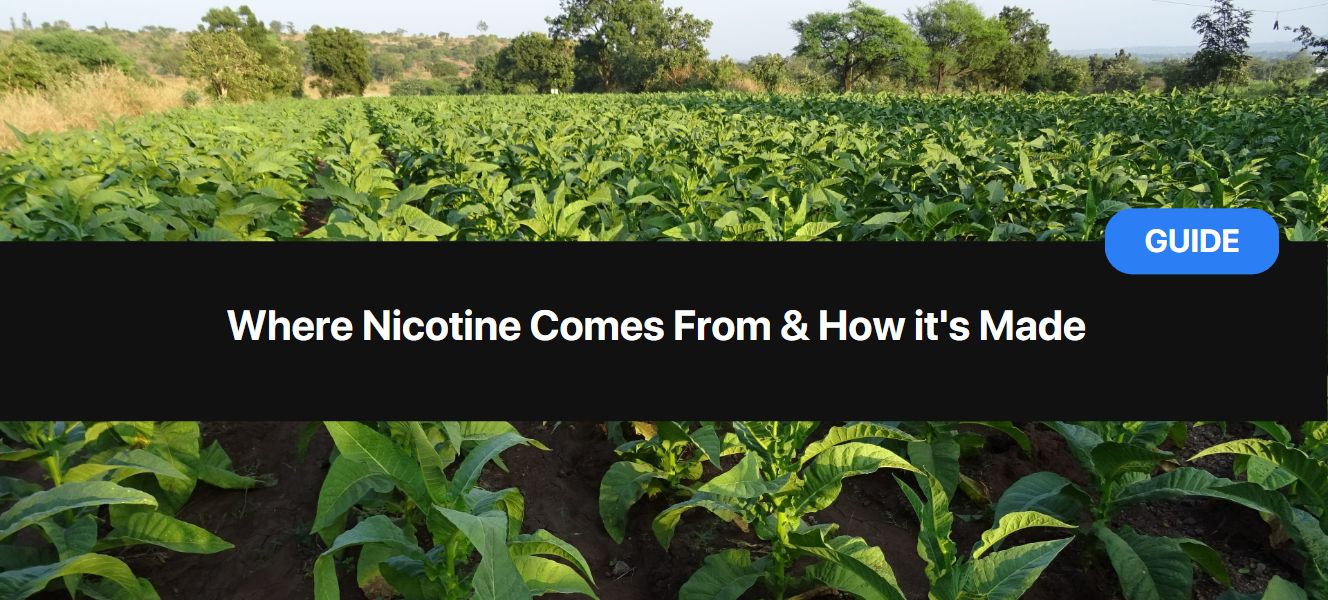UPDATED: Oct 3, 2024
Nicotine is a stimulant chemical found in the Nicotiana Tabacum branch of the Night Shade plants. Natural sources of nicotine include potatoes, eggplants, bell peppers, and other green plants. The highest concentration of nicotine is found in tobacco leaves.
At some point, people used tobacco leaves and found that it gave a pretty good buzz. They took the leaves and used them for medicinal and ritualistic purposes. Slowly, the tradition evolved, the rituals turned into everyday use, and newer products came about.
We'll look at the origins, development, and usage of nicotine pouches in detail. You'll be surprised at some of the things that you'll learn.
What is Nicotine?
Nicotine is an alkaloid, a compound found mainly in the tobacco plants from the nightshade family. Its chemical composition is C10H14N2. Nicotine is a stimulant that accelerates your functions and affects your Parasympathetic Nervous System (PNS).
Nicotine is well known for its stimulatory effects, which affect cognition, memory, attention, focus. These effects can vary depending on constitution and the amount of nicotine you consume. Let's look at these in detail.
What are the effects of nicotine on the body?
The benefits of nicotine pouches on the body include a sense of elevation, improved mood, better cognition, and motivation. When consumed, nicotine reacts with the nicotine acetylcholine receptors (nAChRs). It leads to the release of neurotransmitters like dopamine and serotonin.
You feel a rush of energy, and happiness, in the form of a slight tingling sensation called a nicotine buzz. You'll feel:
- Increased Alertness
- Faster Heartbeat
- Improved Mood
These effects are momentary and reduce in intensity after the initial rush. While, the nicotine rush lasts for a fleeting moment, it still causes nicotine addiction. Yes, nicotine has negative effects as well.
What are the side effects of nicotine on the body?
The biggest side effect of nicotine on the body is dependence. Prolonged and unchecked use of nicotine can cause problems like nicotine dependence. Your body begins to rely so much on nicotine that you fail to function like a normal human being.
You experience brain fog, lethargy, and dietary problems when you do not use nicotine. Nicotine also has a contricting effect on your arteries, which leads to various cardiovascular problems. The intensity of these side effects increase with cigarettes and heated forms of tobacco.
Where Does Nicotine Come From?
Nicotine comes from the tobacco plant also known as Nicotiana tabacum of the Solaneceae family. Other plants from the same family, like the pituri plants from Australia, also have a hallucinogenic effect. Some everyday foods also contain nicotine in trace amounts.
The nicotiana tabacum is an indigenous plant from South West Africa, South America, Australia, and South Pacific. The indigenous people of the Americas would use ceremonial pipes, filled with tobacco, for numerous purposes. Before signing a treaty or covenant, they would pass around a smoking pipe. It was like being in a college frat party!
On October 15, 1492, Christopher Columbus got some dried tobacco leaves as a gift from the American Indians that he encountered. The plant gained instant popularity in Europe and America, as it was believed the plant had “healing powers”. We now know that it was a nicotine rush.

Evolution of Tobacco and Nicotine
After Columbus brought tobacco plants to Europe, they were quickly adopted by the aristocrats. While people did know about the effects of tobacco, they didn't know what was causing it. 1828 German chemists Wilhelm Heinrich Posselt and Karl Ludwig Reimann isolated nicotine and identified its effects.
During the 16th Century, a French Chemist and Ambassador to Portugal, named Jean Nicot identified the medicinal properties of tobacco. He sent tobacco seeds and plants to France where it quickly became popular with the King. Aristocrats would use nasal snus for headaches, migraines, and other pains.
From France, tobacco spread to Sweden, where it gained a foothold. In 1724, King Frederik I passed a decree that promoted the cultivation of snus. Farmers created their own blends, which were limited by pasteurization, which usually took months.
Emergence of Modern Snus and Nicotine (16th Century to 20th Century)
During the later 17th Century, Jakob Fredrik Ljunglöf found a new pasteurization method. This method reduced the time it took to prepare good snus by multiple weeks. Jakob went on to found Ettan Snus, a brand that exists even today.
With Jakob's invention, the age of modern snus had begun. Snus became an everyday item in Sweden, which even today has the lowest number of smokers in the world. Snus had one minor flaw, it was messy and produced saliva.
During the industrialization people wanted something cleaner, so brands created White Portions. These were much cleaner, produced less saliva, and retained quality for longer. By the end of the millenia, even white portions weren't enough.
Enter Nicotine Pouches (20th Century to 21st Century)
At the end of the millennia, brands had started looking for cleaner alternatives to snus and cigarettes. The cigarette crave was peaking and people were experiencing the downsides. In 2000, Dr. Karl Olof Fagerström took the fight to cigarettes.
He formed the brand Niconovum to raise awareness about cigarettes and their negative health effects. Dr. Karl created the first all-white nicotine pouches, which were much safer and cleaner. In 2007, Reynolds American bough Niconovum and rebranded the products.
From 2010 to 2016, research into the effects of cigarettes increased, and tobacco giants faced backlash. In 2017, British American Tobacco identified the importance of tobacco-free alternatives and bought Reynolds American. At the same time, Philip Morris had bought ZYN, and so began the race for all-white nicotine dominance.
How is Nicotine Made?
Nicotine is made by isolating and harvesting the chemical from tobacco leaves. The leaves are ground, washed, fine-powdered, and washed again to remove all the contaminants. Most snus, chewing, and dipping tobacco brands pasteurize this mixture and put it into portions.
Other brands further refine and extract the nicotine through steam distillation or chemical extraction. Once the nicotine is extracted, they turn it into a highly concentrated solution for e-liquids or powder for nicotine pouches and other products.
Nicotine pouch brands like ZYN add ingredients, which include humectant, arabic gum, flavorings etc. Some brands use a more refined version of nicotine, made in a lab through chemical processes, called Synthetic Nicotine.
A tip from Snusdaddy: Nicotine users should bear in mind that even if content labels appear to have been accurately tested and measured, there are still risks associated with potential contaminants present during production. Always read product warnings and seek advice from medical professionals before making any decisions about using nicotine products.

What Are The Effects of Different Nicotine Types?
Nicotine is a stimulant, and it makes you feel more energetic, happy, alert, and active. However, the effects can vary based on the product or type of nicotine that you're using. Let's look at these various effects in detail.
Effects of Nicotine From Cigarettes
When tobacco is burned, it enters the bloodstream and reacts with the receptors. It increases alertness and heart rate, resulting in an increased sense of wellbeing or euphoria. Nicotine also has a dietary suppressing effect, which means you feel less hungry.
Cigarettes also carry a ton of negative health risks. Apart from nicotine, cigarettes also contain over 7000 other chemicals, about 69 of which can cause cancer. Cigarette smoke also constrict your arteries and cause various CVD and COPD problems.
Inhaling smoke from cigarettes or other tobacco-based products poses significant risk to one's respiratory system. Your system becomes inflamed, while your body gets less oxygen because of increased Carbon Monoxide levels.
Effects of Nicotine From Snus
Snus has the same stimulatory effects on your body; however, they do not contain the same toxins. You don't have to deal with tobacco smoke or other major carcinogens, which makes snus safer than cigarettes. Smokeless tobacco products like snus are also more refined and don't damage your gums.
At the same time, snus also contains nicotine which is very addictive. All tobacco products, be it snus, chewing tobacco, dip, or loose tobacco, contain the same risk of addiction. While these products are great for quitting tobacco, we wouldn't recommend using them if you haven't used nicotine before.
Tobacco use can cause mood problems, nicotine dependence, and countless other problems. Use these products sparingly to avoid problems.
Effects of Nicotine From Nicotine Pouches
Nicotine pouches contain clean nicotine, which is much safer compared to snus and cigarettes. These pouches do not affect your gums and are often used as substitutes to cigarettes and smokeless tobacco products.
Modern nicotine pouches are perfect for smoking cessation because they are smoke, spit, and toxin-free. Alternatively, these pouches come in enticing flavors that make your tobacco cessation much easier.
On the downside, nicotine use, be it of any kind is a risky endeavor. Prolonged use of nicotine pouches can cause long-term dependence. You could feel mood shifts, brain fog, lethargy, and some other side effects.
Is Nicotine Addictive?
Yes nicotine is addictive, especially when used for a long time. It is estimated that up to 70% of adult smokers in the United States are nicotine-dependent. Nicotine rewires your reward center, which means you get used to abnormally high levels of serotonin and dopamine.
When you withdraw from nicotine, your endorphins go back to their normal state. However, your body is accustomed to the new highs and thinks the original nicotine levels are too low. You feel:
- Irritability
- Fatigue
- Decreased mood
- Digestion problems
Nicotine withdrawal symptoms are the main reason why most people cannot quit tobacco, e-cigarettes, snus, or nicotine pouches. The worst part is that if left unchecked, users keep increasing their dose of nicotine to relive the nicotine buzz.
Most users who want to quit nicotine rely on Nicotine Replacement Therapies (NRT) options like:
- Nicotine Lozenges
- Nicotine Gum
- Nicotine Patches
- Nicotine Pouches or Nicopods
Recently, a new form of products has come about, that is both nicotine and tobacco-free. These pouches are even safer than nicotine gum, because they do not contain any nicotine. You can try out these nicotine free pouches today to quit smoking or snussing.
Snusdaddy Summary: Where Does Nicotine Come From
Nicotine comes from the Solaneceae family of plants and is found naturally in various vegetables. The highest concentration of nicotine lies in the tobacco plant. Manufacturers refine these plants and extract the nicotine to create snus, nicotine pouches, e-liquids, and other products.
Nicotine is well known for its stimulatory effects and positive impact on alertness. At the same time, it is a very addictive chemical that can have long-term side-effects like brain fog, lethargy. While the side-effects of nicotine vary, nicotine pouches and nicotine-free pouches are the least harmful options.
You can order tobacco-free nicotine pouches or nicotine free pouches with Snusdaddy. We offer the best discounts and deals to help you enjoy your favorite products. Order today to get started and don't forget to leave your thoughts in the comments below.



